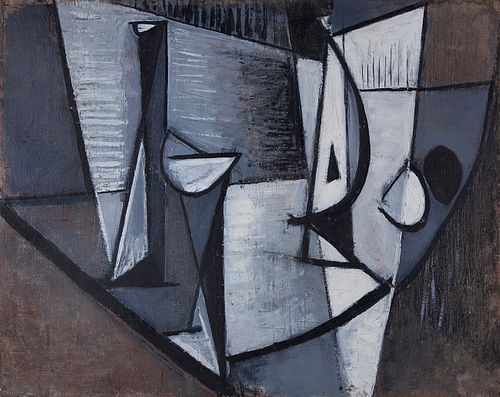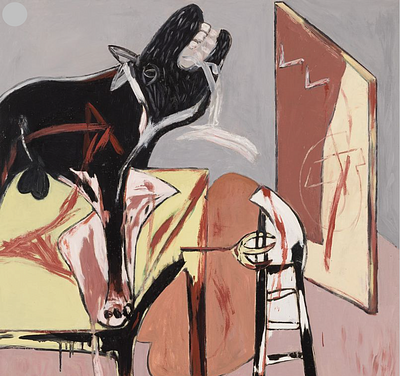"JOSE FIN", JOSÉ VILATÓ RUIZ (Barcelona, 1916 - Paris, 1969). "Composition à la poire" 1949. Oil on canvas.
Lot 90
About Seller
Setdart Auction House
Carrer Aragó 346
Barcelona
Spain
Setdart Subastas was born in 2004 and is currently the first online art auction in Spain with solidity, prestige and reliability guaranteed by our more than 60,000 users. Setdart has a young, dynamic and enterprising team ready to successfully manage the purchase and sale of art works through custom...Read more
Estimate:
EUR€10,000 - EUR€12,000
$10,752.69 - $12,903.23
Absentee vs Live bid
Two ways to bid:
- Leave a max absentee bid and the platform will bid on your behalf up to your maximum bid during the live auction.
- Bid live during the auction and your bids will be submitted real-time to the auctioneer.
Bid Increments
| Price | Bid Increment |
|---|---|
| EUR€0 | EUR€10 |
| EUR€200 | EUR€25 |
| EUR€500 | EUR€50 |
| EUR€1,000 | EUR€100 |
| EUR€3,000 | EUR€200 |
| EUR€5,000 | EUR€500 |
| EUR€10,000 | EUR€1,000 |
| EUR€20,000 | EUR€2,000 |
| EUR€50,000 | EUR€5,000 |
About Auction
By Setdart Auction House
Nov 16, 2021
Set Reminder
2021-11-16 08:00:00
2021-11-16 08:00:00
America/New_York
Bidsquare
Bidsquare : Contemporary and Actual Art
https://www.bidsquare.com/auctions/setdart-auction-house/contemporary-and-actual-art-7839
Setdart Auction House sofia@setdart.com
Setdart Auction House sofia@setdart.com
- Lot Description
"JOSE FIN", JOSÉ VILATÓ RUIZ (Barcelona, 1916 - Paris, 1969). "Composition à la poire" 1949. Oil on canvas. Relined. Signed in the lower right corner: "J.Fin Atelier". Provenance: family of the artist and Sala Dalmau Gallery, Barcelona. Included in the Catalogue of the exhibition "J.Fin" in Sala Dalmau, 2008. Measurements: 68 x 83,5 cm; 85 x 100 cm (frame). This abstract painting by Jose Fin was made by the artist (one of the most singular figures of the so-called Spanish School of Paris) shortly after his liberation from the Argelés concentration camp. It was through the mediation of his uncle Pablo Picasso that Fin, alias José Vilató Ruiz, managed to escape. He then settled in Paris, and would share his studio with Archipenko, Chagall, Foujita, Max Jacob and Modigliani, among others. It was the mythical Le Ruche, a pavilion for Bordeaux wines converted into a meeting place and workshop for the most representative post-war artists. The Parisian stage would be for Fin his most fruitful period: if the first stage (Barcelona) had been characterized by its figurative but anti-academic freshness, in Paris he entered into a dark abstraction without concessions. The painting we are dealing with here bears witness to the expressive power of an artist who was ahead of many of his contemporaries, his imagination and experimental zeal being spurred on by the precariousness in which he lived, which led him to work with newspaper and extra-artistic supports (an "artista povera" a decade before the emergence of "arte povera"). We are before a composition with a post-cubist background but from which emanates a subjugating force that elevates it beyond any influence or legacy. For the path that José Fin took throughout his life was always alien to militancy and avant-garde. Son of the neuropsychiatrist Juan Vilató and Lola Ruiz, Pablo Picasso's sister, Fin was initiated in art in the family home. He trained at the School of Fine Arts of Sant Jordi in Barcelona, and participated for the first time in a group exhibition in the early date of 1932. In 1934 he resided in Mahón, Menorca, where he painted a series of works that he later exhibited in Barcelona. Mobilized, he fought in the war, and in 1939 he went to France. He returned the following year, when he became friends with Manolo Hugué. In 1943 he exhibited in Barcelona, in the Reig Galleries, with his brother Javier, A. Fabra and R. Rogent, in an exhibition that was considered the first artistic revulsive of the postwar period in Barcelona. With a grant from the French government, he settled in Paris in 1946. In the French capital, together with his brother, he frequented the Kahnweiler circle, with friends such as Matisse, Miró, Braque, Lam Leiris, Giacometti, Domínguez, Bores, Viñes, Eulard, Cocteau and, above all, his uncle Picasso. He also held several solo exhibitions during the fifties and sixties, in Paris, Saint Raphael, Barcelona, Bern, Madrid and Mallorca. He also worked in sculpture and mural painting, the latter discipline in which his works for the church of Coscojuela de Sobrarbe (1944) and the CSF factory in Paris (1960) stand out. In 1971 a posthumous anthological exhibition was dedicated to him in Barcelona. The Sala Dalmau in Barcelona held in 2008 the exhibition "Els anys de la Ruche 1946-49", focused on the years that J.Fín spent in the emblematic building of La Ruche in Paris.
- Shipping Info
-
In-house shipping available. Please inquire at admin@setdart.com.
-
- Buyer's Premium



 EUR
EUR CAD
CAD AUD
AUD GBP
GBP MXN
MXN HKD
HKD CNY
CNY MYR
MYR SEK
SEK SGD
SGD CHF
CHF THB
THB















